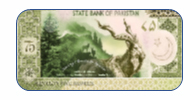Portraits of Founders For the Front of the Banknote, the State Bank of Pakistan selected personalities, who were instrumental in elucidating, shaping and supporting the struggle for independence. For this purpose, the portraits of Quaid-e-Azam Muhammad Ali Jinnah, Sir Syed Ahmed Khan, Allama Muhammad Iqbal, Mohtarma Fatima Jinnah were selected to represent the founding fathers’ struggle for independence.
 | Sir Syed Ahmed Khan
Sir Syed Ahmed Khan was one of the most prominent Muslim reformers and educationists of South Asia, he advocated modern education and reforms in Muslims’ outlook so as to enable them to survive and flourish in the changing environment. He laid the foundation for freedom with Aligarh Movement and establishment of the Aligarh University. He is also considered to be the pioneer of the Two-Nation theory and Muslim nationalism in the Sub-continent.
Picture Credit: From the collections of National Archives | | | |  | Allama Muhammad Iqbal
The philosophical underpinning for a separate Muslim identity was provided by the Poet-Philosopher, Allama Muhammad Iqbal, who reminded Muslims of their latent potential and first proposed the idea of a separate Muslim homeland in the Sub-continent.
Picture Credit: From the collections of National Archives | | | |  | Quaid-e-Azam Muhammad Ali Jinnah
The struggle for independence was headed ably and brought to a fruitful conclusion by Quaid-e-Azam, who thereafter became the face of the nation and the symbol of its unity.
Picture Credit: The photograph of the Quaid-e-Azam used for the banknote is from the rare collection of Mr. Z.D. Barni (Agha Zaiuddin Barni), who was the official photographer for the Quaid-e-Azam during his time as Governor General. | | | |  | Mohtarma Fatima Jinnah
Quaid-e-Azam was supported unfailingly by Mohtarma Fatima Jinnah, whose presence on the banknote serves as a reminder and acknowledgement of the role of women in the freedom movement and the singular price paid by them both during the struggle and immediately following independence.
Picture Credit: From the collections of National Archives |
|






 banknote done by Ms. Sara Khan, a young and upcoming artist from Pakistan. The design includes images of national animal and tree, Markhor and Deodar, respectively, which highlights the importance of saving our environment and Pakistan’s unique Fauna and Flora. The design provided by Ms. Sara Khan was selected by the State Bank of Pakistan as inspirational outline for the vignettes on the reverse side of the commemorative banknote.
banknote done by Ms. Sara Khan, a young and upcoming artist from Pakistan. The design includes images of national animal and tree, Markhor and Deodar, respectively, which highlights the importance of saving our environment and Pakistan’s unique Fauna and Flora. The design provided by Ms. Sara Khan was selected by the State Bank of Pakistan as inspirational outline for the vignettes on the reverse side of the commemorative banknote..jpeg)


